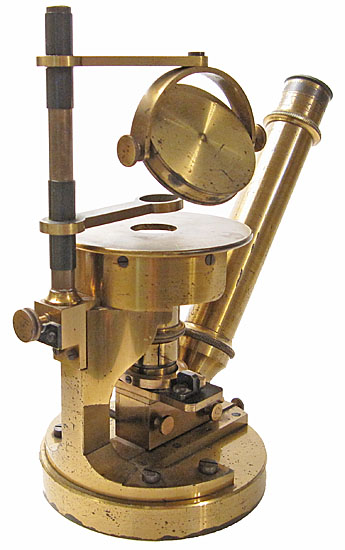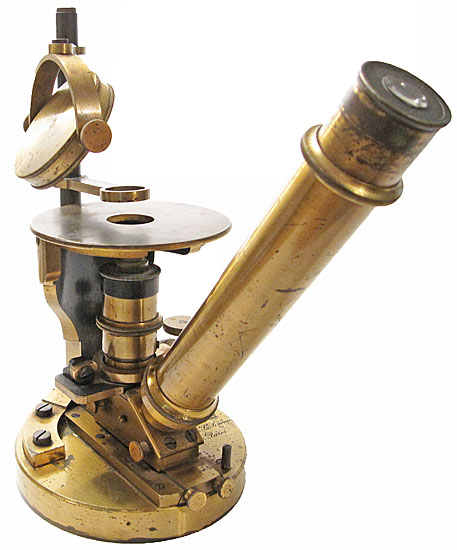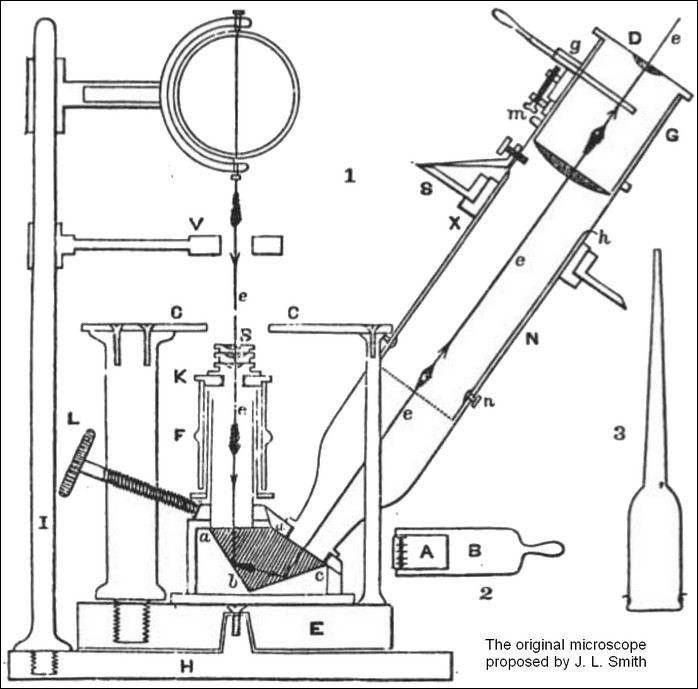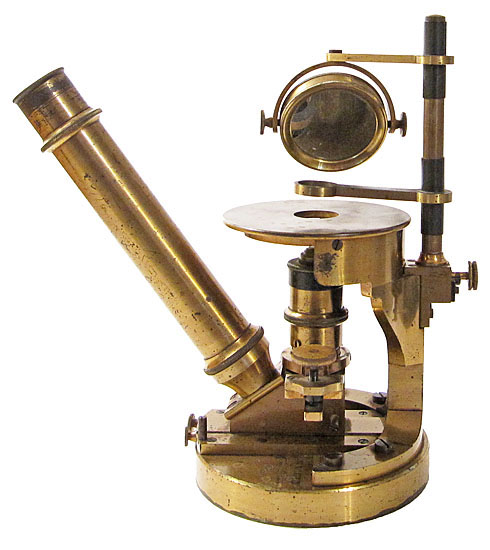
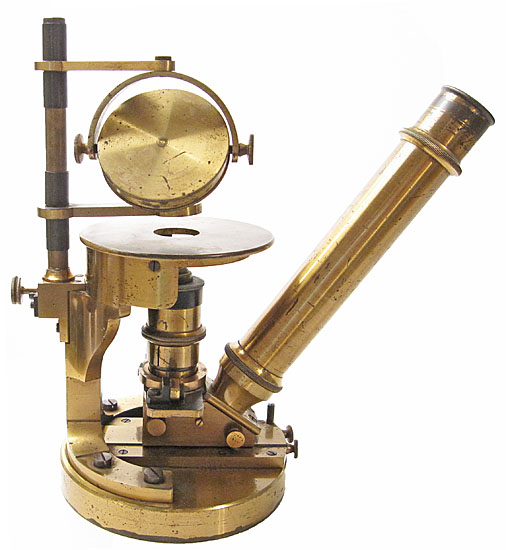
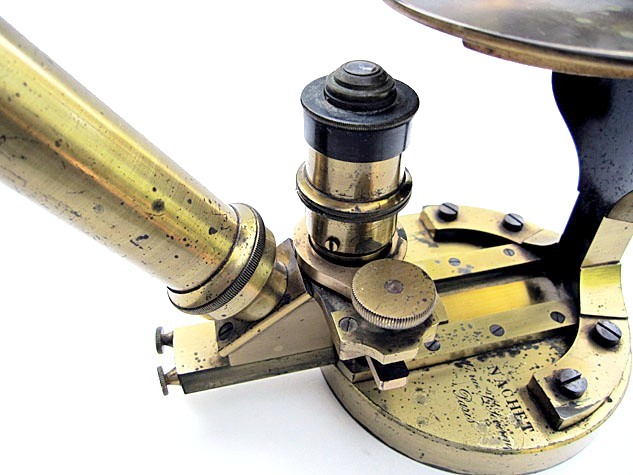
From John Quekett's A Practical Treatise on the Use of the Microscope, 1852
M. Nachet's Microscope For Chemical Observations.
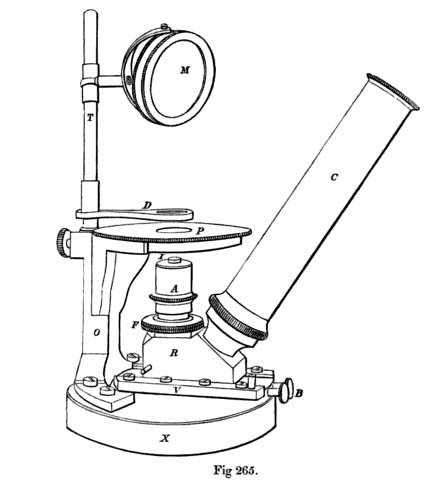
This very valuable instrument is represented in fig. 265, and is composed of a solid foot, X, in which is fixed the piece, O, for the reception of the small plate, P, on which the objects to be examined are placed; as in this instrument we view the under surface of objects, the illumination must be on their upper surface; for this purpose we fix at pleasure to the piece O the rod T, which holds the mirror, M, and the piece, D, for holding the diaphragms, polarizing aparatus, &c. To the foot, X, is attached a dovetailed slide, V, in which is contained a prism, R, supporting the tube, A, and the body, C. Supposing that a particular object is to be viewed, by means of the two milled heads, B, we draw the prism, R, out of the axis of the instrument, as shown in fig. 266, we screw the object-glass to the piece F, we replace the prism under the small plate, and then adjust the focus by means of the tube A and the fine adjustment, F.
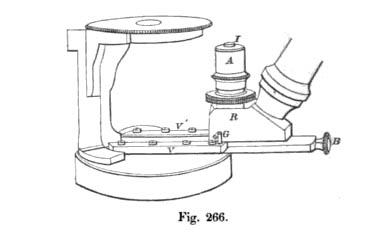
There are in G, fig. 266, two screws, which, coming in contact, prevent R from coming out completely. The office of the prism, R, is to receive the image in a vertical direction, and reflect it to the axis of the body, C, which carries the eye-pieces without any perceptible loss of light. When an object is required to be very much heated, a larger plate, the edges of which are heated by small spirit- lamps, is laid upon the small plate, P. The magnifying powers to be obtained in this microscope vary from 25 to 500 diameters, and all the apparatus necessary for the study of mineralogy can be applied to it, such as the goniometer, micrometer, &c. In short, in the general use of acids, reagents, &c., no injury can happen to the lenses of the object-glasses, as, being placed underneath, they are protected from the oxidizing vapours.
From The Microscope in its Application to Practical Medicine by Lionel Smith Beale, 1858
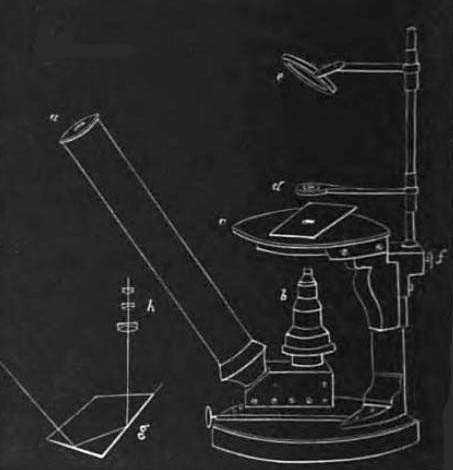
Microscope
for Examining Substances immersed in Acids and
corrosive Fluids. In examining preparations which
require to be immersed in strong acid, in the
ordinary microscope, it is not easy to prevent
the fumes from injuring the brass work of the
instrument. Considerable inconvenience is also
experienced in examining fluids while hot, in
consequence of the vapour which rises, condensing
on the object- glass, and rendering the object
invisible. These inconveniences are entirely
obviated by the ingenious microscope invented
some years ago by Dr. Lawrence Smith, of
Louisville, United States. This was made by M.
Nachet, of Paris, and has been described as
Nachet's chemical microscope.
The inverted chemical microscope is represented
in fig. 106, in which also the form and position
of the prism are shown. By this arrangement the
object-glass is always kept perfectly clear,
while of course the definition of object is not
in any way interfered with. In order to adapt the
instrument to drawing the outline of objects with
the glass reflector, 76, it would only be
necessary to have the body fixed at a right angle
with the axis of the object-glass. A small mirror
at an angle of 45 degrees, might be substituted
for the prism
In the first
edition of this work I must regret having
inadvertently omitted Dr. Smith's name as the
inventor of this instrument. To him ls certainly
due the merit of its invention. Dr. Smith's paper
on the subject, will be found in the " American
Journal of Science," second series, Vol. xiv.,
1852.
The description of the microscope from the 1886 Nachet catalog:
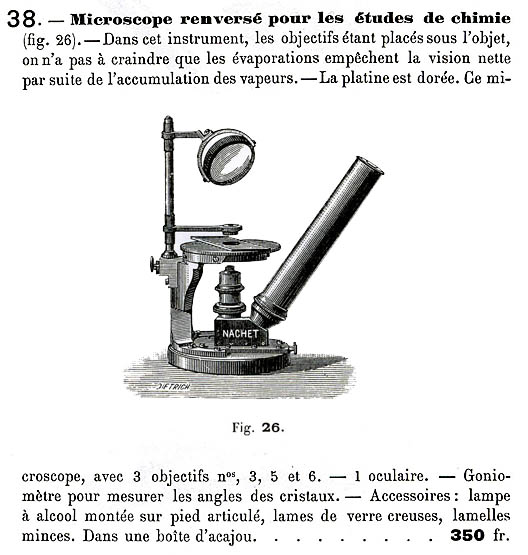
This can be translated as follows:
38.-Inverted microscope for chemical studies (fig. 26). - In this instrument, the objectives are placed below the object, one has not to fear that the evaporations prevent clear vision due to accumulation of vapours. - The stage is gilded. This microscope, with 3 objectives No. 3, 5 and 6, 1 eyepiece, and Goniometer for measuring the angles of crystals. Accessories: alcohol lamp mounted on an articulated base, object glasses, cover slips. In a mahogany box. . . . . . . . . . . 350 fr.
The inverted chemical microscope was first invented by J. Lawrence Smith, professor of chemistry at the University of Louisiana, in 1850. Shortly afterward, the microscope was manufactured by the Nachet firm. The firm continued to produce the microscope, basically unchanged, up to the end of the century. Smith further elaborated on its description in the publication Mineralogy and Chemistry: Original Research, 1873 (this description is essentially identical to the 1852 article referenced above by Beale).
